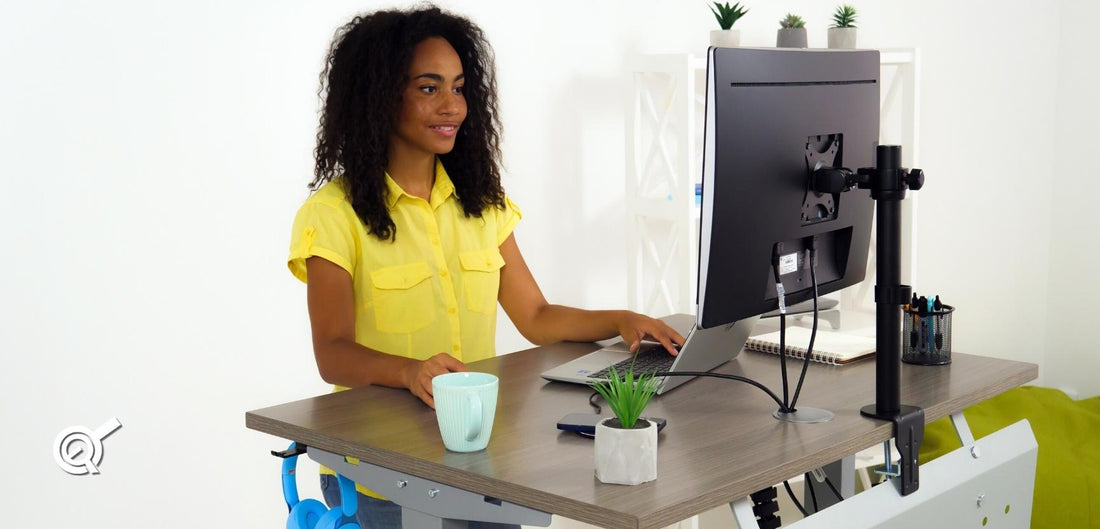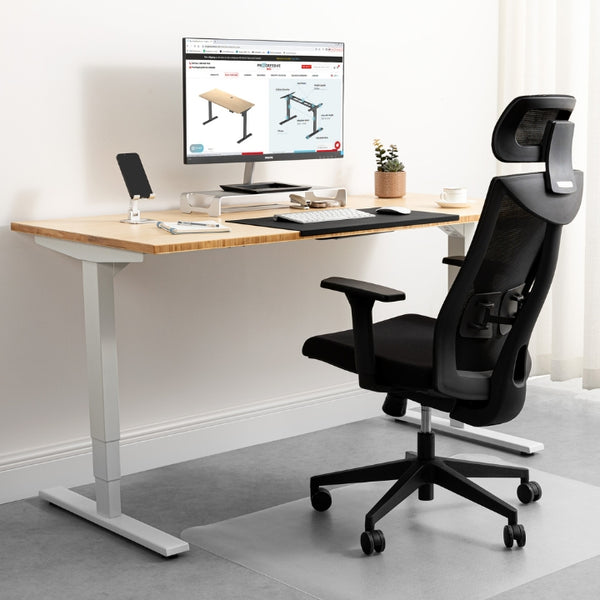Standing desks are becoming increasingly popular as people look for ways to reduce time spent sitting and improve their overall health. While standing desks can offer many benefits, it's crucial to maintain good posture while using them to avoid discomfort and potential health issues such as back and neck pain.
In this article, we will explore the common posture mistakes you can make while using a standing desk and give tips on improving posture and maintaining good ergonomics. Whether you're a seasoned standing desk user or new to the concept, this article will provide valuable information to help you make the most of your adjustable desk and stay healthy and comfortable while you work.
Common Posture Mistakes and How to Avoid Them
Standing desks can help improve posture by promoting an upright and engaged pose, reducing the risk of slouching and hunching. When standing at a desk, it becomes easier to maintain a straight back, engage core muscles, and keep the neck and head in a neutral position. This can help reduce neck, shoulder, and lower back strain and prevent discomfort and pain. However, misusing a standing desk may cause opposite effects, resulting in some posture-related problems.
Let’s look into the most common posture mistakes and how one can avoid them.
Mistake 1: Slouching forward or hunching over the desk
This puts unnecessary strain on the neck, shoulders, and lower back.

How to Avoid
It's important to keep the shoulders relaxed and the chest lifted to maintain good posture. Make sure the desk is at the right height for your work surface. Stand with your feet hip-width apart, keep your shoulders relaxed and chest lifted.
Mistake 2: Leaning on one hip or leg
Applying more pressure on one leg can cause muscle imbalance and lower back pain.
How to Avoid
To prevent these conditions, distribute your weight evenly on both feet and avoid leaning on one side. You can also try using a footrest to shift weight from one foot to another and reduce fatigue.
Mistake 3: Keeping the feet flat on the floor without shifting the weight
Standing in one place for extended periods can lead to fatigue and discomfort.
How to Avoid
Shifting weight from one foot to the other and using small movements such as rocking can help reduce fatigue and improve blood circulation. Additionally, we advise you to use a mat or cushioned flooring, which will serve to relieve pressure on your knees and ankles and make standing more comfortable.

Mistake 4: Not engaging core muscles and keeping a straight back
A strong core helps support the spine and maintain good posture.

How to Avoid
It's crucial to engage the core muscles and keep the back straight, avoiding slouching or hunching. You can also try using a stability ball or back support to help maintain good posture.
Mistake 5: Holding the neck or head in a forward or downward position
Spending long in this position can strain the neck and lead to headaches and neck pain. It's recommended to keep the neck in line with the spine and not tilt the head forward or downward.

How to Avoid
Make sure your standing desk is at the right height and raise your monitor to eye level to prevent neck strain. Take breaks and stretch your neck and shoulders regularly to reduce tension.
Additionally, we’ll cover some frequently asked questions to equip you with more insights on properly using your adjustable standing desk.
FAQ
How high should a standing desk be?
A general guideline for the correct height of a standing desk is to have the work surface at or slightly above elbow height, with the keyboard and mouse positioned at a comfortable level.
To set the ideal height for your standing desk, you can stand up straight, bend your arms in elbows at approximately 90 degrees, and place them conveniently on the desk.
How does the standing desk help in posture correction?
Standing desks help in posture correction by promoting an upright and engaged posture, which reduces the risk of slouching and hunching. When standing at a desk, it becomes easier to maintain a straight back, engage core muscles, and keep the neck and head in a neutral position. This can help to reduce strain on the neck, shoulders, and lower back and prevent discomfort and pain.
While standing desks can help in posture correction, it's essential to watch your posture while using them and take regular breaks to stretch and move. By combining a standing desk with proper posture and ergonomic techniques, you can feel comfortable while working.
How can I eliminate back pain when using my standing desk?
Here are some tips to help eliminate back pain when using a standing desk:
- Adjust the height of the desk to the appropriate level;
- Use an anti-fatigue mat that helps reduce fatigue and provide extra cushioning to your feet;
- Maintain good posture - keep your back straight, shoulders relaxed, and head and neck in a neutral position;
- Take breaks and do stretching - regular breaks to stretch will help decrease muscles stiffness and regain energy;
- Use proper footwear - wearing supportive and comfy shoes contribute to the health of your back and feet;
- Choose an ergonomic chair – sometimes back hurts when standing too long, so the best way to stay fit at work is alternating from standing to sitting on an ergonomic chair, which is designed considering the human body’s anatomy.
A Closing Word
Standing desks give you a perfect chance to stay active throughout your working day and maintain optimal health levels. However, to make the most of this ergonomic equipment, you should mind simple recommendations on proper standing desk usage and benefit from it. Following tips from this blog, you can eliminate back pain when using a standing desk, maintain good posture, and stay comfortable while working. Browse our collection of standing desks or build your own using our Desk Builder. Should you have any questions, we’re here to help!
sales@progressivedesk.com |1-800-828-9414



